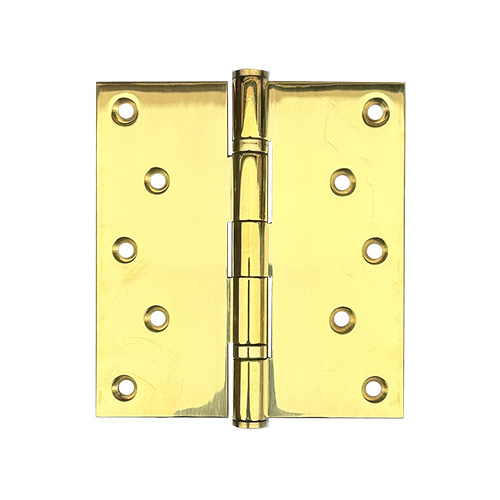How to Properly Install Heavy Duty Stainless Hinges: A Comprehensive Guide
2025-08-12

How to Properly Install Heavy Duty Stainless Hinges: A Comprehensive Guide
Table of Contents
- Understanding Heavy Duty Stainless Hinges
- Tools and Materials Needed for Installation
- Preparing the Installation Area
- Measuring and Marking for Accurate Installation
- Installing the Heavy Duty Stainless Hinges
- Testing and Adjusting the Installation
- Common Installation Mistakes to Avoid
- Maintenance Tips for Heavy Duty Hinges
- Conclusion
- FAQs
Understanding Heavy Duty Stainless Hinges
Heavy-duty stainless hinges are essential components in various applications, particularly in environments where durability and strength are paramount. These hinges are designed to support substantial weight and withstand the elements, making them ideal for outdoor gates, commercial doors, and industrial applications. Their stainless steel construction provides corrosion resistance, enhancing longevity and reliability.
When selecting heavy-duty stainless hinges, consider factors such as load capacity, material thickness, and design. Opting for hinges that are specifically rated for heavy-duty applications ensures optimal performance and safety.
Tools and Materials Needed for Installation
Before diving into the installation process, gathering the necessary tools and materials is crucial. Here’s a comprehensive list to help you get started:
Essential Tools
- Power drill or screwdriver
- Measuring tape
- Level
- Pencil or marker for marking
- Chisel (if needed for mortising)
- Clamps (to hold the door in place during installation)
Materials Required
- Heavy-duty stainless hinges (2-3 depending on door size)
- Screws (typically included with the hinges)
- Wood filler (if necessary for repairs)
Preparing the Installation Area
Preparation is vital for a successful hinge installation. Before starting, ensure that the installation area is clean, dry, and free from debris. If you are installing hinges on an existing door, remove the door and inspect the frame for any damage. Repair any issues to ensure a solid mounting surface.
If you are working with a new door, verify that it's acclimated to the environment where it will be installed. For wooden doors, allow them to adjust to humidity levels to prevent warping.
Measuring and Marking for Accurate Installation
Precise measurements are critical to ensure the proper alignment of hinges. Follow these steps for accurate measuring and marking:
Step 1: Determine the Hinge Placement
The standard placement for hinges is typically 5-7 inches from the top of the door and 8-10 inches from the bottom. For heavier doors, consider adding a third hinge in the middle.
Step 2: Mark the Hinge Locations
Using a pencil, mark the locations on both the door and the frame. Ensure that the marks are level and aligned correctly for a seamless installation.
Step 3: Mortise if Necessary
For a cleaner look and better fit, you may need to mortise the hinge into the door and frame. Use a chisel to create a recess where the hinge will sit, ensuring that it is flush with the surface.
Installing the Heavy Duty Stainless Hinges
With everything measured and marked, it's time to install the heavy-duty stainless hinges. Follow these steps for a successful installation:
Step 1: Position the Hinge
Align the hinge with the marked location on the door. If you mortised the hinge, ensure it sits flush. Use clamps to hold the door in place if necessary.
Step 2: Secure the Hinge
Using your power drill or screwdriver, insert the screws into the hinge. Start with the top screw and work your way down. Ensure that the screws are tight but be cautious not to overtighten, which could strip the hole.
Step 3: Repeat for the Frame
Once the hinge is secured to the door, repeat the process for the hinge on the door frame. Make sure everything is aligned properly before tightening the screws fully.
Step 4: Install Additional Hinges
If your door requires more than two hinges, repeat the above steps for any additional hinges, ensuring they are evenly spaced and aligned.
Testing and Adjusting the Installation
After the hinges are installed, it’s essential to test the door's functionality. Open and close the door several times to ensure smooth operation. If you notice any resistance or misalignment, adjustments may be necessary.
Adjusting the Hinges
If the door doesn't close properly, check the hinge alignment. You may need to loosen the screws slightly, reposition the hinge, and retighten. Additionally, ensure that the door is not dragging against the frame or floor.
Common Installation Mistakes to Avoid
Understanding common pitfalls can save time and frustration. Here are a few mistakes to avoid during installation:
1. Incorrect Measurements
Always double-check measurements before marking. Incorrect placements can lead to misaligned doors.
2. Forgetting to Mortise
Neglecting to mortise can result in a bulky appearance. Always ensure hinges are flush with the door and frame.
3. Over-Tightening Screws
Over-tightening can strip screws or damage the hinge. Ensure screws are snug but not excessively tight.
4. Ignoring Weight Distribution
For particularly heavy doors, always use the recommended number of hinges to distribute weight evenly.
Maintenance Tips for Heavy Duty Hinges
To ensure the longevity and performance of your heavy-duty stainless hinges, regular maintenance is essential. Here are some tips:
1. Regular Cleaning
Keep hinges clean and free from debris. Use a damp cloth to wipe them down regularly.
2. Lubrication
Apply a suitable lubricant to the hinges periodically to ensure smooth operation. Avoid over-lubricating, which can attract dirt.
3. Inspect for Damage
Regularly inspect hinges for signs of wear or rust. Address any issues promptly to prevent further deterioration.
4. Re-tighten Screws
Check screws periodically to ensure they remain tight and secure, especially in high-traffic areas.
Conclusion
Installing heavy-duty stainless hinges may seem daunting at first, but with the right tools, preparation, and knowledge, it can be a straightforward process. By following this comprehensive guide, you'll ensure that your hinges are installed correctly, providing lasting durability and functionality. Remember to maintain your hinges regularly to enjoy their benefits for years to come.
Frequently Asked Questions (FAQs)
1. What are heavy-duty stainless hinges used for?
Heavy-duty stainless hinges are primarily used in applications that require enhanced strength and durability, such as gates, commercial doors, and industrial environments.
2. How many hinges do I need for my door?
Typically, two hinges are sufficient for lightweight doors, while heavier doors may require three or more for proper support.
3. Can I install heavy-duty hinges on a wooden door?
Yes, heavy-duty hinges can be installed on wooden doors, provided that the wood is in good condition and can support the weight.
4. What should I do if my door doesn't close properly after installation?
Check the hinge alignment and ensure that all screws are tight but not overly tightened. Make any necessary adjustments to achieve a smooth operation.
5. How often should I maintain my heavy-duty hinges?
Regular maintenance every few months is recommended, including cleaning, lubrication, and inspections for wear or damage.
By following this detailed guide and understanding the nuances of hinge installation, we can enhance your skills and ensure that your doors function flawlessly for years to come.
PREVIOUS:
Contact Us
E-mail :
ivyhinge@163.com
Phone/WhatsApp:
+86 18924942354
Address:
XIAOLAN TOWN,ZHONGSHAN cIty,GUANGDONG province,China



